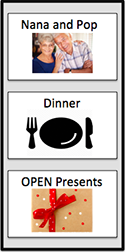Holidays can be a stressful time for individuals with ASD. Lights, music, and seasonal decorations are magical for some people but may lead individuals with autism spectrum disorder to experience sensory overload and anxiety.
The key to preparing for the inevitable changes that come with the holidays is to provide the individual with information about an event or activity. WHAT will be happening? WHEN it will be happening? WHO will be involved and WHERE it will be happening?
—Ten Tips to Prepare for the Holidays—
|
1. CALENDAR: A weekly or monthly calendar can be created to highlight the events throughout the season. The calendar could include when decorations will be put up (or taken down), when family and friends will visit and or a countdown for when the gifts will be opened. |
2. VISUAL SCHEDULE: Make a daily schedule to help the individual anticipate the activities, places and people involved. |
3. SUPPLIES: Create a “Mary Poppins” bag to take along when traveling or attending events or holiday celebrations. Pack the individual’s favorite things that will keep him or her entertained. When possible have the individual select the items and help pack the bag |
|---|---|---|
|
4. SOCIAL NARRATIVES: Prepare the individual for upcoming events or changes in routine by writing or drawing a story that describes what will happen. When possible include photos of the activities, places or the people who will be involved. |
5. QUIET AREA: Identify a calm area where the individual with autism can go and relax if needed.
|
6. ROUTINES: Discuss with family how to minimize disruptions to established routines (e.g. bedtime). |
|
7. TIMING: Timing can be of the essence. What are your child’s needs for downtime, are there times of day when a public place will be less crowded, how meaningful and fun is an activity to the child and will it be best to start with that activity or to put it into a first, then routine to help the child through a less preferred activity. |
8. REHEARSAL: Practice unwrapping gifts ahead of time, to help the individual with autism understand the process and meaning of gift exchange
|
9. VISUAL SUPPORTS: When opening gifts, try passing around a visual cue such as a reindeer hat to signal whose turn it is to open the next gift.
|
|
10. GIFT PREPARATION:
|
||
Download a printable version of holiday tips here
Connect with us…
Join us on Facebook | Visit our website | Sign up for training news





 Being surprised is fun for some but causes anxiety for others. Some individuals might need to know what they are opening: a small part of the item can be left visible when wrapped or the individual might be given a list of the presents he or she will receive.
Being surprised is fun for some but causes anxiety for others. Some individuals might need to know what they are opening: a small part of the item can be left visible when wrapped or the individual might be given a list of the presents he or she will receive.